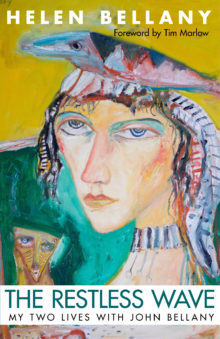When David Bowie went in search of the birthplace of one of his artist heroes he found the house next door was called “Dar es Salaam”. The synchronicity was not lost on him – this was the hometown of his then girlfriend. Where did Bowie’s pilgrimage take him? Not some exotic corner of the world, and nowhere near Tanzania, but a small fishing community in Scotland’s East Lothian, Port Seton.
Famous for its caravan park and coal-fired power station (recently demolished), Port Seton was the birthplace of one of Scotland’s most admired painters, John Bellany. The Restless Wave tells how his wife, Helen, met him at Edinburgh College of Art in the early 1960s, their life together, divorce and remarriage. Bellany’s intriguing, colourful and figurative works with a magic realist quality are visionary and instantly recognisable. The story of the artist as a young man starts in a tiny cold-water flat in Edinburgh’s Rose Street and sees his steady rise to being feted in London and New York and, latterly, enjoying a bucolic life in Tuscany.
A tightknit family and early love-at-first-sight marriage are not the stuff of dramatic biography but Helen Bellany really gets under the skin of the artist’s life and success. Impecunious student days see pints of warm beer in smoky jazz clubs, art college revels, and moth-eaten second-hand clothes from the cat-piss reeking Madame Doubtfire.
Helen and John were soulmates from the outset. They moved to London so he could attend the Royal College of Art and pursue his career, she to have babies. So while he’s off seeing Glenda Jackson on stage and exhibitions of the day (including the Expressionist Max Beckmann) his missus was back home with mum having their first child. By the high-bohemian 60s Helen had given up any pretensions to be an artist and bore no rancour. John eschewed the fashionable op- and pop art of the era, going decidedly his own way. It was Helen who persuaded her husband not to go back to teach at Edinburgh’s art college but continue in the pursuit of his art in London little knowing that one day his work would hang in several major galleries and be part of great private collections.
One of the turning points in his career was a visit to Buchenwald concentration camp in what was then East Germany. Despite John Bellany’s lust for life he was tormented by assorted night terrors, something reflected in many of his paintings. Helen was clearly not merely his muse but also his rock and, to some extent, eminence gris.
The turning point in Helen’s story is her husband’s affair with another woman and their subsequent divorce. Helen too often tells us the laborious details of various comings and goings – the divorce, moving house, being a single mum of three troubled children – but little about how she feels. Suffice to say she doesn’t cope – especially when her two adolescent boys in bovver boots and braces flirt with skinhead racism. The lads are sent to live with dad and report back on his Bacardi-and-Coke elevenses. Their stepmother Juliet, meantime, is often in hospital as she copes with bipolar disorder.
Helen certainly has more than her fair share of crosses to bear. Her husband’s alcoholism resulted in a liver transplant. Surprisingly, the book is never self-pitying nor depressing although occasional purple passages of the most flowery prose are a distraction. It’s almost inevitable that Helen and John get back together again and remarry.
Some 40 years after their student days, during the making of a TV documentary, Helen found herself at the couple’s former digs in Rose Street. She went up the communal stairs and outside the door of her old flat was a tatty piece of hardboard. Amazingly, it was one of her early paintings. But the reader gets little feeling from this incident, or anywhere else in the rest of the book, about how she felt about giving up her art to become mother, social worker and soulmate. Did this domestic life compensate in any way? Did she have even a tinge of regret? Was she envious of her husband? The reader has no idea.
